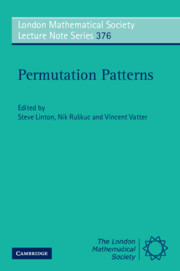Book contents
- Frontmatter
- Contents
- Preface
- Some general results in combinatorial enumeration
- A survey of simple permutations
- Permuting machines and permutation patterns
- On three different notions of monotone subsequences
- A survey on partially ordered patterns
- Generalized permutation patterns – a short survey
- An introduction to structural methods in permutation patterns
- Combinatorial properties of permutation tableaux
- Enumeration schemes for words avoiding permutations
- The lexicographic first occurrence of a I-II-III-pattern
- Enumeration of partitions by rises, levels and descents
- Restricted patience sorting and barred pattern avoidance
- Permutations with k-regular descent patterns
- Packing rates of measures and a conjecture for the packing density of 2413
- On the permutational power of token passing networks
- Problems and conjectures
- References
Problems and conjectures
Published online by Cambridge University Press: 05 October 2010
- Frontmatter
- Contents
- Preface
- Some general results in combinatorial enumeration
- A survey of simple permutations
- Permuting machines and permutation patterns
- On three different notions of monotone subsequences
- A survey on partially ordered patterns
- Generalized permutation patterns – a short survey
- An introduction to structural methods in permutation patterns
- Combinatorial properties of permutation tableaux
- Enumeration schemes for words avoiding permutations
- The lexicographic first occurrence of a I-II-III-pattern
- Enumeration of partitions by rises, levels and descents
- Restricted patience sorting and barred pattern avoidance
- Permutations with k-regular descent patterns
- Packing rates of measures and a conjecture for the packing density of 2413
- On the permutational power of token passing networks
- Problems and conjectures
- References
Summary
A very brief introduction to permutation patterns
We say a permutation π contains or involves the permutation σ if deleting some of the entries of π gives a permutation that is order isomorphic to σ, and we write σ ≤ π. For example, 534162 contains 321 (delete the values 4, 6, and 2). A permutation avoids a permutation if it does not contain it.
This notion of containment defines a partial order on the set of all finite permutations, and the downsets of this order are called permutation classes. For a set of permutations B define Av(B) to be the set of permutations that avoid all of the permutations in B. Clearly Av(B) is a permutation class for every set B, and conversely, every permutation class can be expressed in the form Av(B).
For the problems we need one more bit of notation. Given permutations π and σ of lengths m and n, respectively, their direct sum, π ⊕ σ, is the permutation of length m + n in which the first m entries are equal to π and the last n entries are order isomorphic to σ while their skew sum, π ⊖ σ, is the permutation of length m + n in which the first m entries are order isomorphic to π while the last n entries are equal to π.
- Type
- Chapter
- Information
- Permutation Patterns , pp. 339 - 345Publisher: Cambridge University PressPrint publication year: 2010
References
- 1
- Cited by



